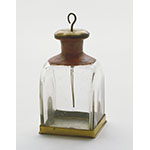Small straw electrometer of the kind described by Alessandro Volta c. 1787. Two straws are in contact with a conductor terminating at the upper end in a brass hook instead of the usual ball. The two long straws are suspended to the brass rod, which terminates in a small ball at the top. A glass jar encloses the lower part of the rod and the straws, preventing them from being moved by air currents. When the conductor is not charged, the straws will align vertically because of gravity. When, instead, the ball is touched by an electrically charged body, part of the charge is diffused throughout the conductor. The straws become identically charged and repel each other, forming an angle proportional to the charge. The phenomenon is based on one of the fundamental properties of electrostatics: bodies with electrical charges of the same sign repel each other, while those with opposite electrical charges attract each other. Two tin-foil grounding strips are in contact with the brass base, whose inside is coated with tin foil.
The instrument is very portable and was used for outdoor observations on atmospheric electricity.
Although these devices were referred to as "electrometers," they are more accurately described as "electroscopes," as by modern standards they are not very accurate and do not measure in absolute units. Provenance: Lorraine collections.










